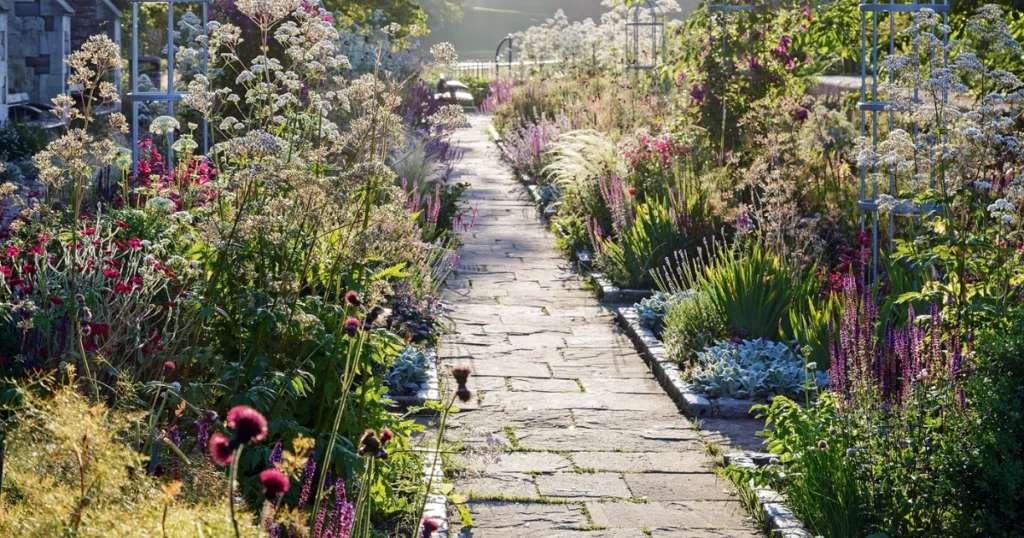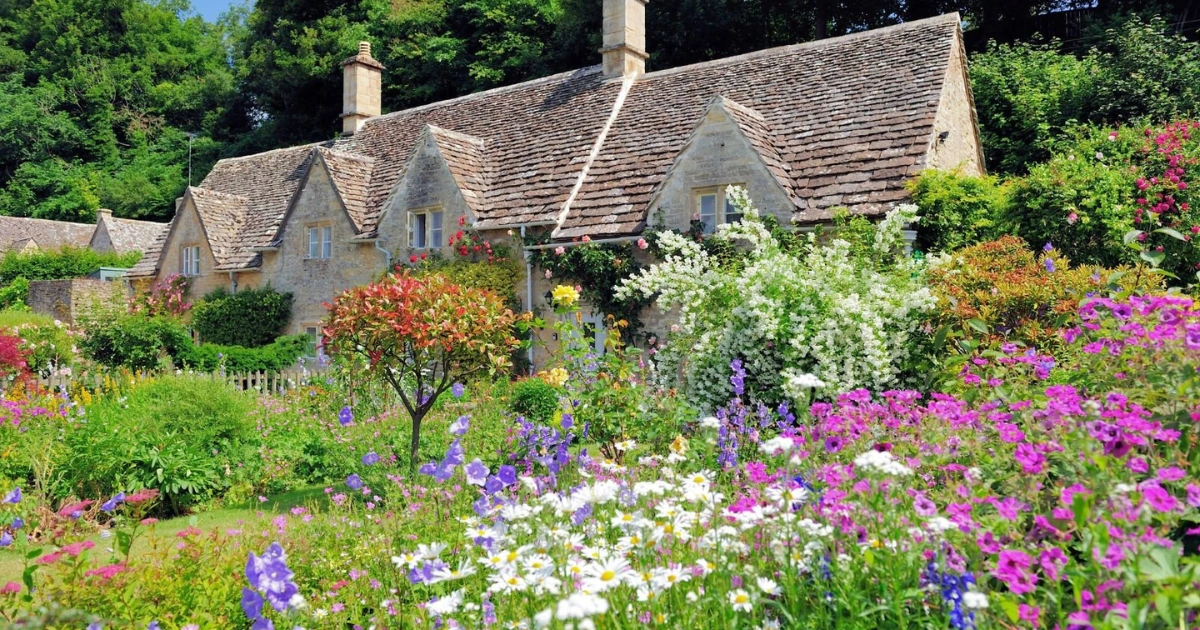Have you noticed how gardens across different regions are starting to look identical? Whether you’re strolling through a coastal village in Brittany or visiting a sunbaked corner of Provence, you’ll likely see the same clipped thuja hedges, the same laurel bushes, and neatly manicured lawns that struggle with drought or frost.
This visual uniformity might seem harmless, but it’s quietly harming the environment and erasing the rich natural heritage of each region. This article will guide you through the benefits of rewilding your garden using native plants and how doing so restores biodiversity, supports pollinators, and reclaims your region’s identity.
If you’re passionate about restoring balance in your garden, don’t miss related guides like How to Create a Pollinator-Friendly Landscape and Wild Garden Design Inspiration

🌍 Why Most Gardens All Look the Same
Across France and beyond, a startling pattern has emerged. Gardens have been reduced to a set of common choices: fast-growing cloned hedges, water-hungry lawns, and exotic flowering plants not suited to the climate. Why? Because big nurseries prioritize profitability, offering mass-produced plants that are easy to market but rarely regionally adapted.
The problem is that France isn’t a single climate. It’s a patchwork of microclimates, each with its own flora. Yet these differences are ignored in modern garden planning. Instead of honoring this diversity, we’re paving over it with standardized greenery.
🐝 The Hidden Cost of Imported Plants
When we plant species that don’t naturally occur in our area, we break the ancient relationship between flora and fauna. Native insects, birds, and soil microbes have evolved alongside native plants. When those plants vanish, so do the creatures that depend on them.
For example, many butterfly species lay their eggs only on specific native plants. If these are replaced with foreign varieties that look pretty but offer no sustenance, the butterfly population collapses. And since birds depend on caterpillars to feed their chicks, the problem grows.
Exotic plants often:
- Require extra water, fertilizer, and pesticides
- Fail to support native pollinators
- Crowd out wildflowers or invade natural areas
- Add nothing to your local ecosystem
🌱 Why Native Plants Are Better
Native plants are those that evolved in a particular region without human interference. They are:
- Adapted to the local soil, climate, and weather extremes
- Supportive of local wildlife, including bees, butterflies, and birds
- Resilient to drought, disease, and pests
- Easier to grow and maintain without chemical inputs
Choosing native plants means choosing balance. You reduce the need for watering and fertilizing, while helping rebuild the food chain—from insects to birds and beyond.
France recognizes the importance of this approach. The “Végétal local” label guarantees that seeds and plants come from your biogeographical region. This isn’t just a stamp—it’s a promise that the plant belongs where it’s planted.
✅ Step-by-Step: How to Rewild Your Garden
Ready to turn your garden into a haven for biodiversity? Here’s how to begin
- Observe your space
Take note of the sun, shade, moisture, wind, and type of soil. Is it sandy, rocky, clay-heavy, or well-draining? - Research local native plants
Look for plant lists specific to your region. Use resources like botanical conservatories or nurseries that carry the “Végétal local” certification. - Design in layers
Nature uses a multi-layered structure: trees, shrubs, perennials, ground cover. Mimic this with native options for each. - Create habitat features
Incorporate piles of logs, insect hotels, water basins, and bird feeders to make your garden attractive to wildlife. - Use organic mulch
Avoid plastic and synthetic mulch. Instead, use leaves, bark, straw, or grass clippings to retain moisture and feed soil life. - Plant in the right season
The best times are autumn and early spring. Avoid planting during heatwaves or frost periods. - Allow wild corners
Designate a section of your garden to grow untamed. Wildflowers and native grasses will appear, often from the seed bank in your soil. - Avoid chemicals
Say no to pesticides and herbicides. Let predatory insects and birds handle pests naturally. - Stay flexible
A rewilded garden changes over time. Be willing to adapt as nature takes its course.
Want to combine this approach with sustainable garden layout? Check out How to Build Permaculture Zones
🌦️ Seasonal & Regional Tips
France’s diverse geography requires different approaches depending on where you live. Here’s how to adapt
Spring
Sow native wildflower seeds in open beds or meadows. Add perennials like native poppies and daisies.
Autumn
Plant trees and shrubs during this cooler, wetter season. Roots will develop before the next summer.
Summer
Water early in the morning. Focus on drought-resistant plants like thyme, lavender, and rosemary.
Winter
Do not plant during hard frosts. Instead, build habitat features and mulch beds. Leave stems and seedheads for wintering insects and birds.
Regional Highlights
- Brittany: Gorse, heather, sea holly
- Pyrenees: Gentian, alpine grasses, martagon lilies
- Provence: Strawberry tree, evergreen oak, rockrose
📦 Tools & Materials Checklist
To begin your rewilding journey, gather the following
- 🪴 Native plants with Végétal local labels
- 🧤 Gardening gloves and basic tools
- 🐝 Insect hotel or log pile for habitat
- 📖 Native plant guide or regional flora book
- 💧 Water dish for birds and insects
- 🌿 Organic mulch (leaf litter, straw, bark)
- 🏷️ Plant labels to track species
- 🔍 Soil test kit (optional, for pH and structure)
❌ Common Mistakes to Avoid
Even with good intentions, many gardeners fall into the same traps. Here’s how to avoid them
- Planting exotic species labeled as “easy”
They often provide no benefit to local wildlife. - Overwatering
Most native plants are adapted to natural rainfall patterns. - Over-clearing the soil
Removing all organic matter strips life from the soil. Leave some mulch and dead leaves. - Impatience
A wild garden doesn’t look perfect overnight. It evolves over months and years. - Too tidy
Wildlife needs mess—logs, leaves, stones, seed heads. Don’t clean up everything.
🌟 Why Rewilding Is Worth It
Rewilding brings life back into your garden in a way no imported flowerbed can. Here’s what you gain
- 🐝 A boost in pollinator activity
- 🐦 More birds nesting and singing
- 💧 Less watering and lower maintenance
- 🌍 A smaller environmental footprint
- 🎨 A natural look unique to your region
- 🧘 A sense of peace and purpose
Your garden becomes part of something bigger—a movement to restore harmony between people and nature.
❓ Frequently Asked Questions
Why are native plants better than regular garden plants?
They’re adapted to local conditions, need less maintenance, and support wildlife.
Can I mix native and non-native plants?
Yes, but prioritize natives. Avoid invasive or high-maintenance exotics.
How can I find out which plants are native to my region?
Use online databases, regional conservatories, or ask for Végétal local certification at nurseries.
What if I only have a small space or balcony?
You can still rewild with potted native plants, window boxes, and insect-friendly herbs.
Will my garden still look beautiful?
Absolutely. Native gardens offer a wild charm, seasonal color, and lively movement.
💬 Final Thoughts: A Garden That Tells a Story
Your garden is more than decoration—it’s a story about where you live. Every plant you choose can either support your local ecosystem or undermine it.
By choosing native species, you’re helping pollinators return, birds nest, and soil regenerate. You’re restoring the beauty that once defined your region.
Whether you start with a corner of wildflowers or replace a hedge with hawthorn, each step matters. You don’t need to go all-in overnight. Just begin—nature will meet you halfway.
We’d love to hear from you. What native plants grow best in your area? Have you spotted more bees, birds, or butterflies since switching to local species?
Share your journey in the comments and inspire others to plant with purpose.
And don’t forget to explore more rewilding ideas at Secrets of the Green Garden
Let’s grow wild together 🌱


https://t.me/s/iGaming_live/4864
https://t.me/officials_pokerdom/4066
برای دوستانی که به دنبال یک راهکار مطمئن برای وریفای حساب در بروکرهای فارکس هستند، پیشنهاد میکنم خدمات شوپی را بررسی کنند. این مجموعه به صورت تخصصی، وریفای قانونی حساب های فارکس را با مدارکی ارائه میدهد که کاملاً معتبر بوده و به نام خودتان صادر میشود. این روش دائمی است و ریسک بلاک شدن حساب شما را به صفر میرساند. کیفیت و پشتیبانیشان واقعاً عالی است.